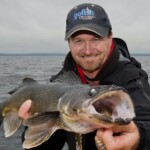The next two shows of this season are going to be of great interest to anybody who fishes more than one day at a time. They’re about having one day when you can do no wrong, and the very next day when you’re wondering what the heck happened. They’re about structure and pressure, and how modern sonar can turn an otherwise “skunky” day into a day you can brag about to your buddies.
In the first of these two episodes, Pete is fishing Lake Nagagami Walleye.
According to our sources, this is one of the best structure lakes in the province. It is located 29 kilometres northwest of Hornepayne, Ontario, in the Algoma district. Our home base for the next five days will be the nearby Timberwolf Lodge.
First, let’s talk about structure. For as long as we’ve been in boats, whether fishing or exploring, mariners have been desperate to know what was below them. How many times did they have to run aground to figure that one out?
One of the first methods used to explore this question was line sounding: Lines with a lead weight at the end running along the bottom, and markers every six feet or so, allowing them to read the water depth. Then, as science progressed, it was echo-sounding or sonar, a device that emitted sound waves to the bottom and recorded the time it took them to bounce back. Higher and lower areas appeared wavy on the graph. This gave us hydrographic or contour maps that a lot of us still use today.
These days sonar has become a very sophisticated, complex, computer-based science that can map the floor of a body of water with remarkable precision. It’s like looking at a three-dimensional photograph.
Gone are the days of just relying on the local old-timers telling you where the hot spots are.
FIND AN EDGE
So what is structure, and why is it so important that we find it? Most fishermen have a pretty good idea what it is, but as a refresher: Structure is any change in contour of the bottom of a body of water that causes a change in depth.
Points, vertical bluff walls, humps, submerged islands, ledges, and creek channels are a few examples. They all have the same common denominator: an edge — a change in depth. Find an edge and you’ll likely find a fish.
Nagagami Lake was gouged out of the earth by the Laurentide Glacier about 10,000 years ago. It has huge inflows (the Foch and Obakamiga rivers) and a massive outflow (the Nagagami River), so the lake is well circulated and well oxygenated, and therefore full of nutrients.
Nagagami is also full of fish: Pike, Perch, Whitefish and, most predominantly, Walleye. The complicated structure at the bottom of this lake, complemented by all these fish, presents the perfect stage upon which to showcase modern-day technologies like Garmin’s portable EchoMap. This tool allowed Pete to locate and read the structure, and add waypoints so he could easily return to any given point on the lake. It also showed him exactly where the fish are within the structure — an otherwise impossible feat.
The weather on this day was perfect: a bright day with a few clouds and a little chop on the water. Fish were all over the place and relatively shallow, around twelve feet. But they were noticeably concentrated around and along ridges.
By splitting the screen on the Garmin, Pete could see where the boat was, relative to the ridge, on the GPS screen; and where the fish were, relative to the boat, on the fishfinder screen. By marking the hits with waypoints, he could maneuver back to the exact spots along that breakline whenever he wanted.
GARMIN TRICK
“On this trip, I discovered a great little trick on my Garmin for Walleye fishing,” explains Pete. “Once I located my fishing area, I turned my unit on to the split frequency screen. The 200 kh on the left side shows bottom features with fantastic detail, but not so great on fish. The 77 kh on the right defines actual fish with perfect clarity, but only the basics on structure. If you are fishing for Walleye or any other species of fish close to the bottom, it’s a must to check out the split frequency screen.”
“What a great day,” continues Pete. “Once I dialled in the structure, I literally caught fish after fish. But it wasn’t all about the electronics. Mother Nature and her barometer had a lot to do with it, too. I didn’t realize it at the time, but I was fishing on the cusp of a falling barometer: a pre-frontal low when all the creatures in the food chain are active.”
As usual, Ontario’s Algoma region didn’t disappoint!
SPECIAL THANKS
- Timberwolf Lodge on Nagagami Lake
- Days Inn & Suites Sault Ste. Marie
- Go Fish In Ontario
- Ontario’s Algoma Region
- Kathy and Derrick Carlson
- Forde Lake Air Service











